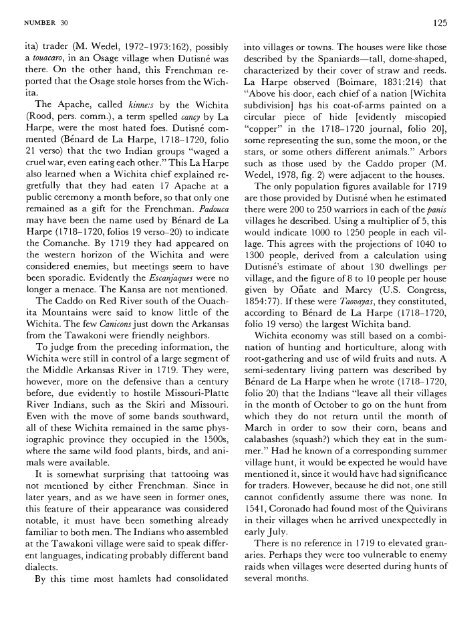Plains Indian Studies - Smithsonian Institution Libraries
Plains Indian Studies - Smithsonian Institution Libraries
Plains Indian Studies - Smithsonian Institution Libraries
You also want an ePaper? Increase the reach of your titles
YUMPU automatically turns print PDFs into web optimized ePapers that Google loves.
NUMBER 30 125<br />
ita) trader (M. Wedel, 1972-1973:162), possibly<br />
a touacaro, in an Osage village when Dutisne was<br />
there. On the other hand, this Frenchman reported<br />
that the Osage stole horses from the Wichita.<br />
The Apache, called kinne.s by the Wichita<br />
(Rood, pers. comm.), a term spelled cancy by La<br />
Harpe, were the most hated foes. Dutisne commented<br />
(Benard de La Harpe, 1718-1720, folio<br />
21 verso) that the two <strong>Indian</strong> groups "waged a<br />
cruel war, even eating each other." This La Harpe<br />
also learned when a Wichita chief explained regretfully<br />
that they had eaten 17 Apache at a<br />
public ceremony a month before, so that only one<br />
remained as a gift for the Frenchman. Padouca<br />
may have been the name used by Benard de La<br />
Harpe (1718-1720, folios 19 verso-20) to indicate<br />
the Comanche. By 1719 they had appeared on<br />
the western horizon of the Wichita and were<br />
considered enemies, but meetings seem to have<br />
been sporadic. Evidently the Escanjaques were no<br />
longer a menace. The Kansa are not mentioned.<br />
The Caddo on Red River south of the Ouachita<br />
Mountains were said to know little of the<br />
Wichita. The few Canicons just down the Arkansas<br />
from the Tawakoni were friendly neighbors.<br />
To judge from the preceding information, the<br />
Wichita were still in control of a large segment of<br />
the Middle Arkansas River in 1719. They were,<br />
however, more on the defensive than a century<br />
before, due evidently to hostile Missouri-Platte<br />
River <strong>Indian</strong>s, such as the Skiri and Missouri.<br />
Even with the move of some bands southward,<br />
all of these Wichita remained in the same physiographic<br />
province they occupied in the 1500s,<br />
where the same wild food plants, birds, and animals<br />
were available.<br />
It is somewhat surprising that tattooing was<br />
not mentioned by either Frenchman. Since in<br />
later years, and as we have seen in former ones,<br />
this feature of their appearance was considered<br />
notable, it must have been something already<br />
familiar to both men. The <strong>Indian</strong>s who assembled<br />
at the Tawakoni village were said to speak different<br />
languages, indicating probably different band<br />
dialects.<br />
By this time most hamlets had consolidated<br />
into villages or towns. The houses were like those<br />
described by the Spaniards—tall, dome-shaped,<br />
characterized by their cover of straw and reeds.<br />
La Harpe observed (Boimare, 1831:214) that<br />
"Above his door, each chief of a nation [Wichita<br />
subdivision] has his coat-of-arms painted on a<br />
circular piece of hide [evidently miscopied<br />
"copper" in the 1718-1720 journal, folio 20],<br />
some representing the sun, some the moon, or the<br />
stars, or some others different animals." Arbors<br />
such as those used by the Caddo proper (M.<br />
Wedel, 1978, fig. 2) were adjacent to the houses.<br />
The only population figures available for 1719<br />
are those provided by Dutisne when he estimated<br />
there were 200 to 250 warriors in each oi the panis<br />
villages he described. Using a multiplier of 5, this<br />
would indicate 1000 to 1250 people in each village.<br />
This agrees with the projections of 1040 to<br />
1300 people, derived from a calculation using<br />
Dutisne's estimate of about 130 dwellings per<br />
village, and the figure of 8 to 10 people per house<br />
given by Onate and Marcy (U.S. Congress,<br />
1854:77). If these were Taovayas, they constituted,<br />
according to Benard de La Harpe (1718-1720,<br />
folio 19 verso) the largest Wichita band.<br />
Wichita economy was still based on a combination<br />
of hunting and horticulture, along with<br />
root-gathering and use of wild fruits and nuts. A<br />
semi-sedentary living pattern was described by<br />
Benard de La Harpe when he wrote (1718-1720,<br />
folio 20) that the <strong>Indian</strong>s "leave all their villages<br />
in the month of October to go on the hunt from<br />
which they do not return until the month of<br />
March in order to sow their corn, beans and<br />
calabashes (squash?) which they eat in the summer."<br />
Had he known of a corresponding summer<br />
village hunt, it would be expected he would have<br />
mentioned it, since it would have had significance<br />
for traders. However, because he did not, one still<br />
cannot confidently assume there was none. In<br />
1541, Coronado had found most of the Quivirans<br />
in their villages when he arrived unexpectedly in<br />
early July.<br />
There is no reference in 1719 to elevated granaries.<br />
Perhaps they were too vulnerable to enemy<br />
raids when villages were deserted during hunts of<br />
several months.

















